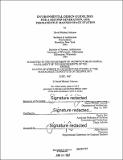| dc.contributor.advisor | Ranko Bon. | en_US |
| dc.contributor.author | Johnson, David Michael, 1960- | en_US |
| dc.contributor.other | Massachusetts Institute of Technology. Dept. of Architecture. | en_US |
| dc.date.accessioned | 2012-11-19T19:07:16Z | |
| dc.date.available | 2012-11-19T19:07:16Z | |
| dc.date.issued | 1987 | en_US |
| dc.identifier.uri | http://hdl.handle.net/1721.1/74786 | |
| dc.description | Thesis (M.S.)--Massachusetts Institute of Technology, Dept. of Architecture, 1987. | en_US |
| dc.description | MICROFICHE COPY AVAILABLE IN ARCHIVES AND ROTCH. | en_US |
| dc.description | Includes bibliographical references (pages 107-109). | en_US |
| dc.description.abstract | This thesis is a continuation of the thoughts and efforts of the author's participation and co-organization of the Space Station Design Workshop (SSDW). The SSDW was a student run event whose inception surfaced in the Spring of 1986, materialized over the summer of that year, and subsequently "launched" itself in the Fall term. The emphasis of the SSDW was on the development and design of a deployable truss system which would be transported in, and deployed from, the cargo bay of the space shuttle. The design emphasis on deployability over an erectable system was based upon the former's lower construction overh~ the creation of "instant real estate", and the inherent lower Extravehicular Activity (EVA) time resulting in a higher margin of crew safety. This thesis is a continuation of the groundwork laid by the SSDW into the design criteria and implementation strategy for the living habitat of a six man Space Station. The scope of the thesis can be summarized in its six sections: 1. A study of appropriate space station analogs with a presentation of conclusions and recommendations based upon the findings. 2. A study of the anthropometrics of the human body in a zero-gravity environment with a presentation of conclusions and recommendations based upon the findings. 3. A study of the physiological effects of zero-gravity on the human body with a presentation of conclusions and recommendations based upon the findings. 4. A study of three strategies of interior module design with a presentation of conclusions and recommendations based upon the findings. 5. A presentation of the the current NASA Space Station art as a basis of comparative study to this thesis' proposed design. 6. A presentation of a complete space station design proposal and implementation strategy based upon recommendations of the preceeding studies. | en_US |
| dc.description.statementofresponsibility | by David Michael Johnson. | en_US |
| dc.format.extent | [1], 152 leaves | en_US |
| dc.language.iso | eng | en_US |
| dc.publisher | Massachusetts Institute of Technology | en_US |
| dc.rights | M.I.T. theses are protected by
copyright. They may be viewed from this source for any purpose, but
reproduction or distribution in any format is prohibited without written
permission. See provided URL for inquiries about permission. | en_US |
| dc.rights.uri | http://dspace.mit.edu/handle/1721.1/7582 | en_US |
| dc.subject | Architecture. | en_US |
| dc.title | Environmental design guidelines for a second generation, LEO, permanently manned space station | en_US |
| dc.title.alternative | Second generation LEO, permanently manned space station | en_US |
| dc.type | Thesis | en_US |
| dc.description.degree | M.S. | en_US |
| dc.contributor.department | Massachusetts Institute of Technology. Department of Architecture | |
| dc.identifier.oclc | 16988098 | en_US |

